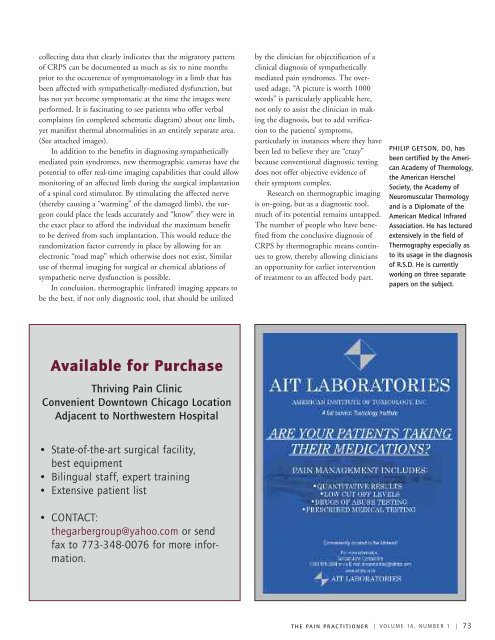printer-friendly version (PDF) - Reflex Sympathetic Dystrophy ...
printer-friendly version (PDF) - Reflex Sympathetic Dystrophy ...
printer-friendly version (PDF) - Reflex Sympathetic Dystrophy ...
Create successful ePaper yourself
Turn your PDF publications into a flip-book with our unique Google optimized e-Paper software.
collecting data that clearly indicates that the migratory pattern<br />
of CRPS can be documented as much as six to nine months<br />
prior to the occurrence of symptomatology in a limb that has<br />
been affected with sympathetically-mediated dysfunction, but<br />
has not yet become symptomatic at the time the images were<br />
performed. It is fascinating to see patients who offer verbal<br />
complaints (in completed schematic diagram) about one limb,<br />
yet manifest thermal abnormalities in an entirely separate area.<br />
(See attached images).<br />
In addition to the benefits in diagnosing sympathetically<br />
mediated pain syndromes, new thermographic cameras have the<br />
potential to offer real-time imaging capabilities that could allow<br />
monitoring of an affected limb during the surgical implantation<br />
of a spinal cord stimulator. By stimulating the affected nerve<br />
(thereby causing a “warming” of the damaged limb), the surgeon<br />
could place the leads accurately and “know” they were in<br />
the exact place to afford the individual the maximum benefit<br />
to be derived from such implantation. This would reduce the<br />
randomization factor currently in place by allowing for an<br />
electronic “road map” which otherwise does not exist. Similar<br />
use of thermal imaging for surgical or chemical ablations of<br />
sympathetic nerve dysfunction is possible.<br />
In conclusion, thermographic (infrared) imaging appears to<br />
be the best, if not only diagnostic tool, that should be utilized<br />
by the clinician for objectification of a<br />
clinical diagnosis of sympathetically<br />
mediated pain syndromes. The overused<br />
adage, “A picture is worth 1000<br />
words” is particularly applicable here,<br />
not only to assist the clinician in making<br />
the diagnosis, but to add verification<br />
to the patients’ symptoms,<br />
particularly in instances where they have<br />
been led to believe they are “crazy”<br />
because conventional diagnostic testing<br />
does not offer objective evidence of<br />
their symptom complex.<br />
Research on thermographic imaging<br />
is on-going, but as a diagnostic tool,<br />
much of its potential remains untapped.<br />
The number of people who have benefited<br />
from the conclusive diagnosis of<br />
CRPS by thermographic means continues<br />
to grow, thereby allowing clinicians<br />
an opportunity for earlier intervention<br />
of treatment to an affected body part.<br />
PHILIP GETSON, DO, has<br />
been certified by the American<br />
Academy of Thermology,<br />
the American Herschel<br />
Society, the Academy of<br />
Neuromuscular Thermology<br />
and is a Diplomate of the<br />
American Medical Infrared<br />
Association. He has lectured<br />
extensively in the field of<br />
Thermography especially as<br />
to its usage in the diagnosis<br />
of R.S.D. He is currently<br />
working on three separate<br />
papers on the subject.<br />
Available for Purchase<br />
Thriving Pain Clinic<br />
Convenient Downtown Chicago Location<br />
Adjacent to Northwestern Hospital<br />
State-of-the-art surgical facility,<br />
best equipment<br />
Bilingual staff, expert training<br />
Extensive patient list<br />
•<br />
•<br />
•<br />
• CONTACT:<br />
thegarbergroup@yahoo.com or send<br />
fax to 773-348-0076 for more information.<br />
T H E PA I N P R A C T I T I O N E R | V O L U M E 16 , N U M B E R 1 | 73
















